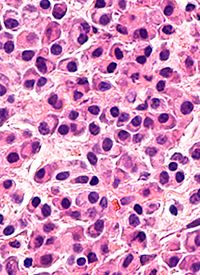Article
Maintenance Lenalidomide Safe, Should Be Continued in Patients With Myeloma Who Contract COVID-19
Author(s):
Maintenance treatment with lenalidomide was found to be a safe treatment for patients with multiple myeloma who are diagnosed with COVID-19, supporting use of the immunomodulatory drug in this patient population.
Multiple myeloma

Maintenance treatment with lenalidomide (Revlimid) was found to be a safe treatment for patients with multiple myeloma who are diagnosed with COVID-19, supporting use of the immunomodulatory drug (IMiD) in this patient population, according to single-center findings presented during the 2nd European Myeloma Network Meeting.
Data showed that the infection mortality rate was 23.8% in patients who were COVID-19 positive and on maintenance lenalidomide compared with 33.3% for those who had COVID-19 and not on lenalidomide. The recovery rates in both arms were 76.2% and 66.7%, respectively.
“Although cytopenias and immunoparesis may develop during continuous maintenance, lenalidomide seems to be safe and has effects in favor of less severe COVID-19 forms and also similar mortality among multiple myeloma patients,” said Ekin Kircali, MD, in the Department of Hematology at Ankara University School of Medicine, in Ankara, Turkey, in a virtual presentation of the data. “Based on our experience, we do not recommend discontinuation during this pandemic.”
Lenalidomide maintenance following consolidation therapy with high-dose melphalan is a common approach known to prolong progression-free survival in patients with myeloma, Kircali noted in her presentation. Lenalidomide may also induce neutropenia and lymphopenia, which in turn exposes patients to infections, including COVID-19.
However, small case series and other reports have suggested that IMiDs could protect patients from severe cases of COVID-19.
In the study presented during the meeting, investigators evaluated 60 patients with multiple myeloma between March 2020 and December 2020 and compared outcomes of those who received continuous lenalidomide maintenance (n = 42) vs no lenalidomide (n = 18).
Patient demographics were broken down into 3 groups: those who were COVID-19 positive and receiving lenalidomide (n = 21), COVID-19 negative and on lenalidomide (n = 21), and those who were COVID-19 positive and not on lenalidomide.
In the COVID-19–positive/lenalidomide group, the median age was 61 years (range, 57-70), and 10 patients were female. The number of lenalidomide cycles was 16 (range, 9-99), and 14 patients had a very good partial response (VGPR) or better to therapy; the neutrophil counts and lymphocyte counts were 1.43 (range, 0.74-9.2) and 0.97 (range, 0.01-2.84), respectively. IgG, IgA, and IgM levels were 7.94 mg/dL (range, 3.2-19.1), 0.69 mg/dL (range, 0.1-3.5), and 0.31 g/L (range, 0.1-0.7), respectively.
Also, in this arm, patients had either non-severe COVID-19 (n = 15) or severe COVID-19 (n = 6), and 5 patients died. The infection fatality rate was 23.8% and the recovery rate was 76.2%.
In the COVID-19–negative/lenalidomide group, the median age was 63 years (range, 58-71), and 11 patients were female. Sixty-one cycles (range, 10-90) of lenalidomide were given, and 18 patients had a VGPR or better to therapy. The neutrophil count was 1.65 (range, 0.77-4.24), and the lymphocyte count was 1.40 (range, 0.31-2.72). The IgG, IgA, and IgM levels were 9.46 mg/dL (range, 2.8-32.7), 1.73 mg/dL (range, 0.0-206), and 0.24 g/L (range, 0.1-0.9), respectively.
Within this group, 1 patient had died; the infection fatality rate was 4.8% and the recovery rate was not applicable as no patients here had COVID-19.
Finally, in the COVID-19–positive group without lenalidomide, the median age is 66 years (range, 46-79) and 12 patients were female. The number of lenalidomide cycles was not available, and 8 patients had a VGPR or better to therapy. The neutrophil count and lymphocyte count were 3.21 (range, 0.45-67.48) and 1.03 (range, 0.03-3.81). The IgG, IgA, and IgM levels were 10.25 mg/dL (range, 2.6-113), 0.41 mg/dL (range, 0.0-2.2), and 0.26 g/dL (0.0-1.3), respectively.
In this arm, 11 patients had non-severe COVID-19 and 7 patients had a severe case of the virus. Six patients died; the infection fatality rate was 33.3% and the recovery rate was 66.7%.
Reference
- Kircali, E, Seval GC, Toprak SK, et al. Outcome of COVID-19 infection occurring during lenalidomide maintenance. Presented at: 2nd European Myeloma Network Meeting; March 3-6, 2021; virtual. Abstract P34.








